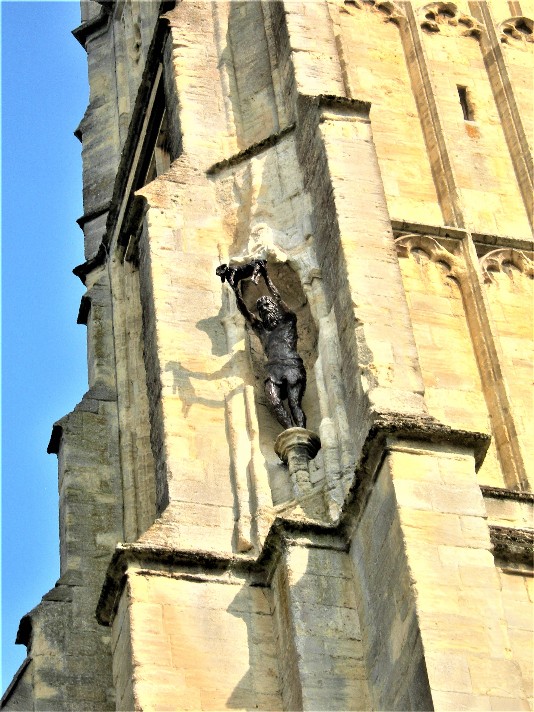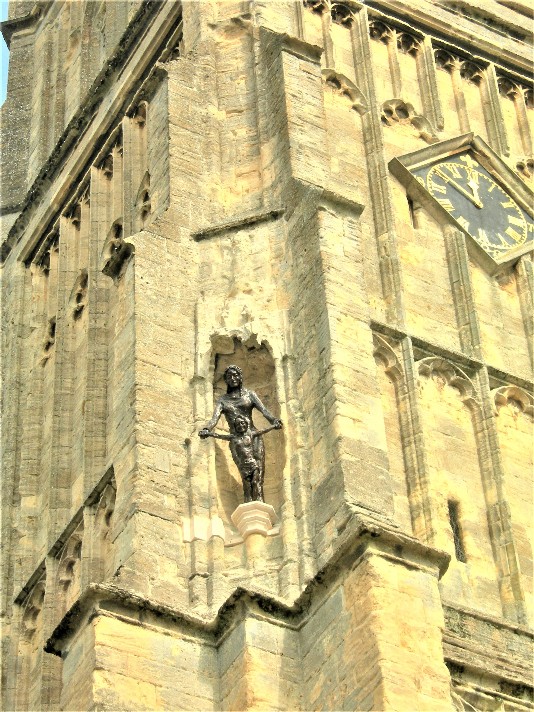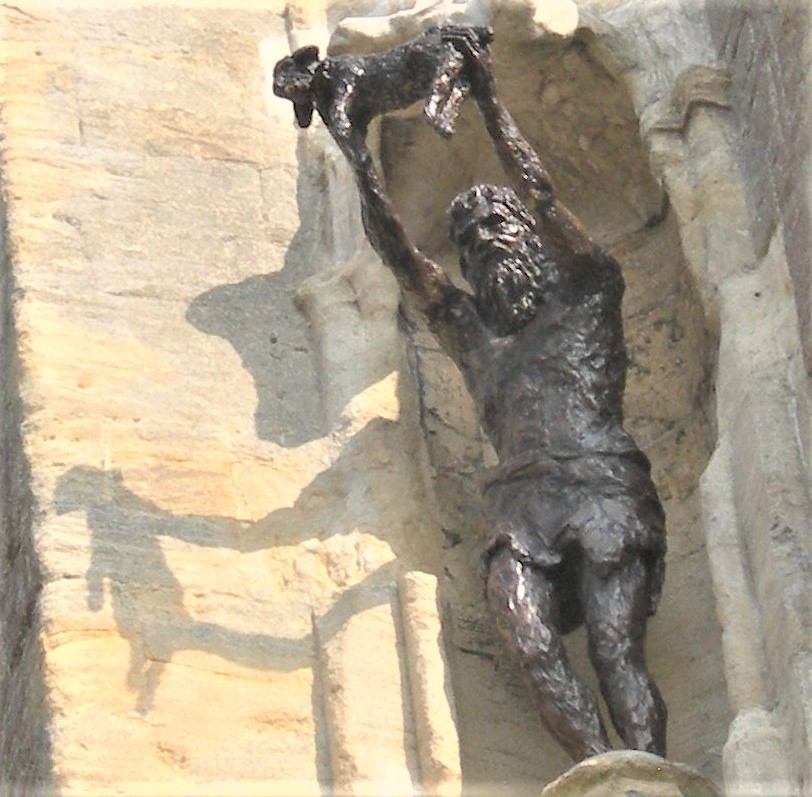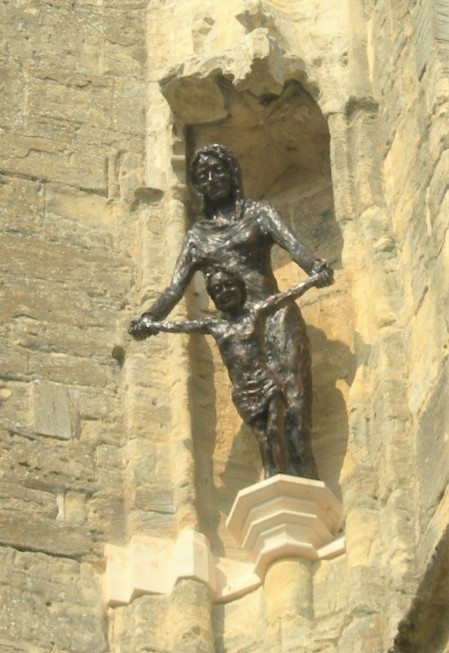
Sculpture for the niches of St. John Baptist Church, Cirencester.
"Project Blackjack"

Throughout 2021 I was extremely privileged to work on a prestigious commission to produce two sculptures, each over two metres high, for the tower of the beautiful church of St. John Baptist in Cirencester; one of the Baptist, and the other of the Virgin and Child. Entitled "Project Blackjack", the commission was for the replacement of two stone sculptures removed from niches half-way up the tower in the 1960s, because they had become dangerous. They were also blackened with age, which is probably why the street beneath the statue of St. John became, over the years, known as Blackjack Street.
While the commission was in process, I recorded all stages of production through to final installation, and these can be seen by clicking here.
My aim was to make a statement about the relevance that St. John the Baptist and the Virgin Mary have within the context of contemporary Christianity. I also wished to affirm the understanding (expressed in the brief) that the Parish Church stands at the spiritual heart of the community. In doing so, I wanted to produce contemporary works that were visually interesting, whilst taking care that they did not jar with the ancient structure of the church. The sculptures should appear to be a natural part of that structure, to which they should be complementary.
The sculpture of John the Baptist:
At first, I saw this charismatic figure from the wilderness as the easier of the two pieces. I envisaged him brandishing the cross with which he is frequently represented in religious icons; a harsh figure, last of the Old Testament prophets who brought a message of destruction as the consequence of man's sin. He would signify a contrast between the Old and New Testaments, between which he formed a bridge. The cross he brandished would prefigure the crucifixion, and link him to the sculpture of the Virgin and Child.
With the passage of time, I felt that although the image could be an impressive one, I was finding it difficult to relate personally to this figure of John, and I expressed my difficulty to Cirencester's vicar, Canon Morris. In discussion, he told me that he had seen a picture of the Baptist with piercing eyes which looked through the observer, and said that he saw this as signifying that God was looking through John; that John was not important to himself, but saw himself as an intermediary. Subsequently two members of the congregation pointed out the John Baptist window, depicting the Baptist holding a lamb, the only image I have seen of him doing so as a man (normally such images show him as a child), and it was suggested that the lamb might have been included because of the importance of the wool trade to the town.
Following these conversations, I rethought my representation, and John now holds out a lamb – "the Lamb of God" – over the town and over the people into which he is looking. For me, this is a more relevant link to the New Testament, and I am happy that it also refers back to Cirencester's past, and its present within a farmed countryside. As with my representation of Andrew, the Fisher of Men for Plymouth, I believe that linking the religious and lay contexts of a location is important in bringing the whole community together; and I am minded of the Eucharist I attended on one of my visits to Cirencester, when the door of the church was left wide open, and I felt strongly that it symbolised the way the church invited and embraced the town.

The sculpture of the Virgin and Child:
It seems to me that representations of Mary inevitably pose some problems within the Protestant tradition. Her role as a mediator between man and God, once so important within the Roman Catholic church, raises difficulties. Similarly, the once significant and schismatic distinction between the titles of Mother of God and Mother of Christ which led to her being viewed as “The Queen of Heaven” have evaporated, and make the traditional crowned image, still to be seen occasionally, remote. At the same time, a simple image of a mother and child can easily become one that might be any mother with any child, or at worst be sentimentalized.
In order to address these problems, I decided to present the Virgin holding a standing Christ-child by both hands, as he leans out of the niche in a position typical of a child's curiosity and fearlessness, whilst at the same time being suggestive of his crucifixion. As Mary holds him, the sculpture will be both Madonna and Child, and Pietà.

Both sculptures bear witness to the centrality of Christ, and the importance of the Incarnation.
Below is a short film produced by the Barn Theatre Company in Cirencester which gives some of the background details of the project. This is followed by a BBC West Television presentation, a film clip taken on the scaffolding, and a film of the blessing of he sculptures by Bishop Rachel of Gloucester from a cherry picker.
On the evening the statues arrived at the church, I was invited to give an illustrated talk on where I considered my sculpture stood within the context of Christian art as a whole. The subject has continued to fascinate me ever since, and has resulted in a small book entitled The Road to Emmaus - a sculptor's journey through time, which will be published by SLG Press later this year.
I want to take this opportunity to thank all those who have made this project possible. Firstly the project committee, and particularly its secretary. Meg Blumsom; and the Vicar, Canon Graham Morris, for his boundless enthusiasm and theological advice. I also want to thank the foundry, Bronze Age, for their continuing help, support, and immense skill. They are so often the unsung heroes of sculptural work. Likewise, my thanks go to Lucy Branch, the conservator, for her invaluable advice; to the architect, Antony Feltham-King, and to Andrew Hewitt and his team at Artful Logistics, without whose expertise the sculptures would not have been in place. Lastly, I wish to thank the people of Cirencester, who have given the sculptures and me a tremendous welcome. It should never be forgotten that all public artworks are a team effort, of which the artist is only a part.
The eminent conservator Lucy Branch, whose company Antique Bronze looks after many of the most important bronze sculptures in London, including Nelson's Column, Eros and the Albert Memorial, interviewed me during the course of this project.. The interview can be heard on Lucy's website, Sculpture Vulture, which contains references to her own work and interests, together with podcast links and transcripts of other interviews.

